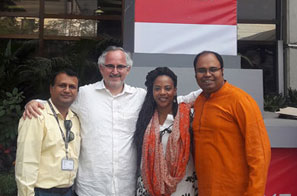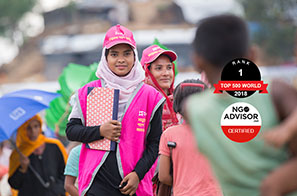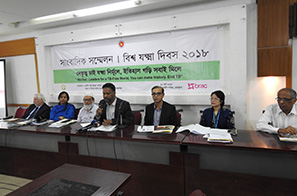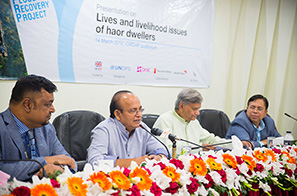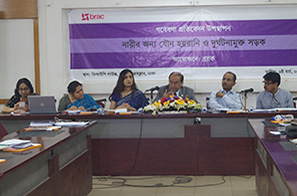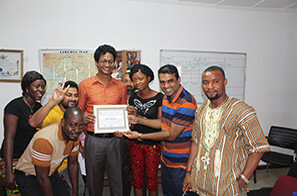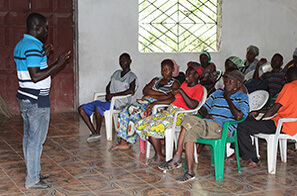
English (965)
Children categories
BRAC receives USD 1.5 million from Bill & Melinda Gates Foundation
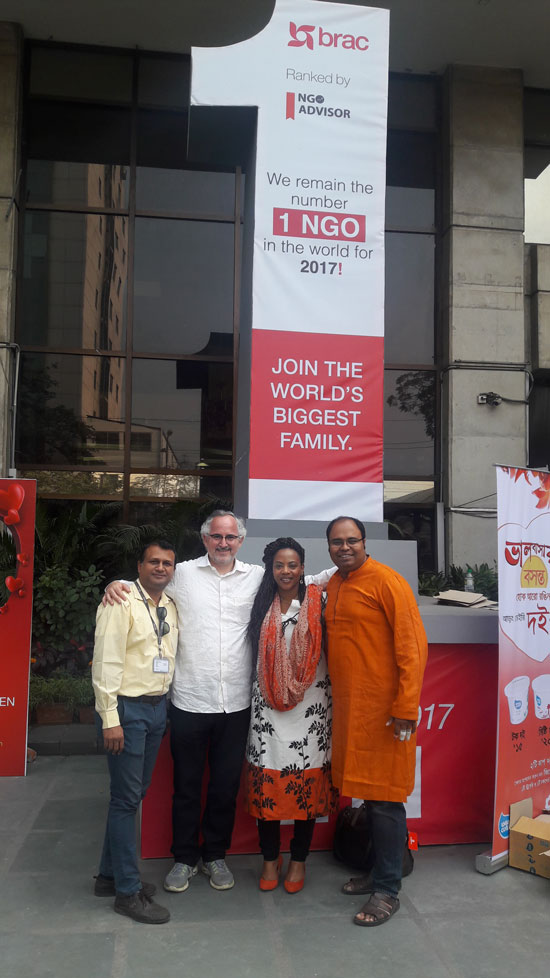
BRAC received a contribution of USD 1.5 million from the Bill & Melinda Gates Foundation in November 2017 to build its preparedness and emergency response capacity in BRAC International’s head office, Sierra Leone, Uganda and Myanmar. BRAC will employ a community-based approach to assist women, children, youth and local government representatives to build resilience against disasters.
Sir Fazle Hasan Abed shared that the Bill & Melinda Gates Foundation has been a key partner in building the emergency response capacity of BRAC. The partnership becomes stronger with this fund commitment. He also mentioned that right now, we are facing the greatest conflict around the world since the Second World War: the crises in Syria and South Sudan require large-scale humanitarian responses, so we have to work not only for Bangladesh, but also for other countries. BRAC International is now focusing on building capacity and preparedness in order to be able to respond effectively in humanitarian emergencies.
BRAC has developed the capacity of staff working in Bangladesh for the last 10 years, providing rapid humanitarian assistance to help more than 2 million people around the world recover from disasters. As Sir Fazle Hasan Abed said, “As we live and work in disaster-prone environments, we need to build our capacity to understand the nature of disasters and how to act in emergency situations, keeping BRAC’s principles and values in mind, and act accordingly".
Researchers have shown that a dollar invested in building local preparedness reduces at least eight dollars in losses from disasters. Studies have shown that the preparedness approach is highly effective and has positive long-term impacts. The funding will allow BRAC to develop a model of disaster preparedness in Sierra Leone, Uganda and Myanmar to strengthen localisation, an approach that focuses on community ownership. The localisation agenda was recognised at the World Humanitarian Summit (WHS) in 2016 and received funding commitments from development partners, foundations, international organisations, UN and philanthropists. BRAC aims to build the resilience capacity of six local governments, six schools and six communities using this model and plans to replicate it in other countries.
BRAC ranked top global NGO of 2018
BRAC tops NGO Advisor’s list of the best non-governmental organisations in the world for the third year running.
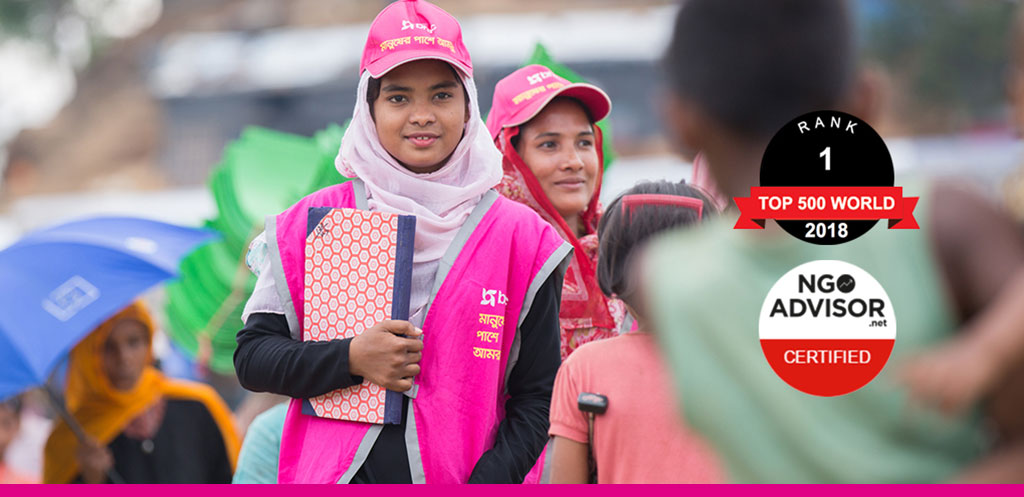
BRAC, an international development organisation and global leader in developing cost-effective, evidence-based programmes in conflict-prone and post-disaster settings, was today ranked the number one NGO in the world for 2018. The ranking was done by NGO Advisor, an independent media organisation based in Geneva. BRAC took the top spot for the third year in a row as part of the 2018 Top 500 NGOs World rankings.
“We are deeply honoured to be ranked as the Top Global NGO for the third consecutive year,” said BRAC Founder and Chairperson, Sir Fazle Hasan Abed. “This accolade belongs to all BRAC staff for championing the BRAC values of integrity, innovation, inclusiveness and effectiveness in everything we do. Our 110 million plus programme participants worldwide, who play an active role in their own transformative journeys, are the real winners. We are inspired by their resilience and spirit to continue striving for a just and equitable world.”
NGO Advisor releases the Top 500 NGOs World rankings each year to highlight outstanding organisations in the nonprofit sector. It conducts exhaustive research, evaluates hundreds of NGOs against a rigorous set of criteria, and ranks these organisations according to a robust methodology. This marks the fourth time in five years that BRAC has earned the number one ranking.
“For any organisation to be a part of the top 100, not to mention the top ten, they need to score strongly in the three pillars of our methodology: innovation, impact, and governance. BRAC continues to chart new territory in all three, pioneering creative, cost-effective, and sustainable interventions that reach millions of the most vulnerable people worldwide,” said NGO Advisor Editor-in-Chief Jean-Christophe Nothias in a statement.
BRAC is one of the few development organisations based in the global south that operates worldwide. Founded in Bangladesh in 1972 and today active in 11 countries, this distinct perspective ensures success for an organisation that runs programmes in microfinance, education, healthcare, legal rights, girls’ empowerment, and agriculture; socially responsible businesses; a bank; a university; and one of the world’s largest mobile money platforms, bKash.
BRAC has an annual global expenditure exceeding $1 billion. The organisation is also unique in that the majority of its programmes are self-financed. In Bangladesh, more than 75 percent of its budget comes from its own social enterprises. In 2017, this was a key determinant for NGO Advisor, which noted this innovative cost-recovery model and focus on sustainability.
“Dynamism is one of our core strengths,” said Dr. Muhammad Musa, Executive Director of BRAC. “BRAC goes beyond the traditional NGO definition and has a unique, integrated model to drive positive social change, including development programmes, social enterprises, investments and university. 2017 has been a landmark year for BRAC as we have also extended our work in humanitarian crisis management to support almost a million Forcibly Displaced Myanmar Nationals, or Rohingyas, coming into southern Bangladesh. We will continue to evolve and focus on a humanitarian development approach, to maximise the impact for both displaced people and host communities. In the long run, we aim to leverage our expertise to support people in crises anywhere in the world."
BRAC is ranked alongside NGOs at the forefront of the international development sector, with Médecins Sans Frontières, also known as Doctors Without Borders; the Danish Refugee Council; the Skoll Foundation and Ashoka, both of which support and enable social entrepreneurship worldwide.

80% TB patients remain undiagnosed
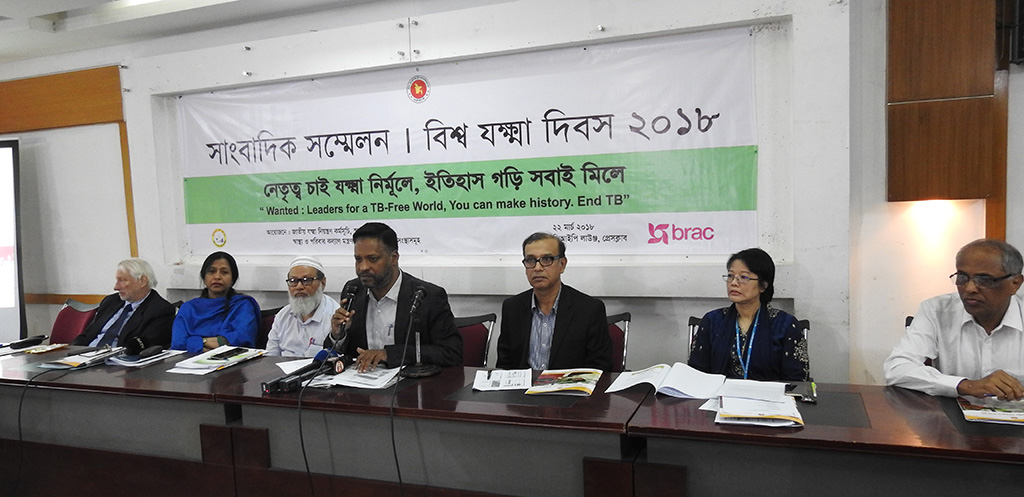
Although the government's overall success continues in tuberculosis treatment, control of multi-drug resistant TB or MDR TB remains a major challenge, mainly due to complications in diagnostic process. Still now, Estimated 80% of the patients with MDR TB infection cannot be diagnosed. Moreover, treatment cannot be reached to 33 per cent patients contracting any kind of TB. However, despite there are diagnostic problems, treatment success for pulmonary TB in the country is as high as 95 per cent.
Experts revealed the information at a press conference today on Thursday (22 March 2018) at the National Press Club. Health and family welfare ministry, National TB Control Programme (NTP) and BRAC organised the event on the occasion of World TB Day to be observed on 24 March.
Dr Md Abul Khair Basher presented the keynote paper at the press event. NTP Medical Officer Dr Nazis Arefin Saki gave a presentation on the NTP management, while its Monitoring and Evaluation Expert Dr Ahmedul Hassan Khan gave the welcome speech. NTP line director Professor Dr Samiul Islam moderated the question and answer session with the press.
Among other guests present at the press conference were World Health Organisation Medical Officer Mya Sapol, National Anti-tuberculosis Association of Bangladesh (NATAB) president Mozaffar Hossain Paltu, USAID Senior Adviser for infectious diseases Dr Charles Lerman, International Centre for Diarrhoeal Disease Research, Bangladesh scientist Dr Sayra Banu and BRAC Director Dr Md Akramul Islam.
Speakers mentioned shortage of GeneXpert machines used for MDR TB detection as a major hindrance in this regard. Lack of awareness and length of MDR TB treatment duration are also important factors for many not completing the full treatment course.
According to the NTP, 2 lakh 44 thousand and 201 patients were detected with TB and received treatment in 2017 through this government entity. Of them, 10 thousand and 189 are less than 15 years old. Further, 12 patients have been diagnosed as extensively drug resistant (XDR).
The keynote speech stressed that in Bangladesh 221 individual’s contract TB infection every year and 40 die of the infection (Global TB report 2017). The statistics itself highlights the urgency of deploying sufficient equipment as well as strengthening the mass awareness campaign in this regard.
Professor Dr Samiul Islam said the country's success in diagnosing and treating tuberculosis between 1993 and 2018 bears the evidence of the achievement of the National TB Control Programme. Under NTP, the rate of diagnosis is 77 per cent per one lakh population and that of recovery 95 per cent per one lakh.
He further said that despite the success Bangladesh is still one of the 30 countries most vulnerable to this infection. He called for all to work unitedly to free the country from TB.
Mya Sapol stressed collaborative effort between the government and the non-governmental sector in controlling TB.
Dr Md Akramul Islam called on the mass media to play a stronger role in TB control campaign through dissemination of information about the efforts undertaken at both the government and the non-governmental level. He further said, prevalence of TB infection is high among urban and elderly population. Giving special emphasis on urban TB control he said, this initiative are under expansion in the slums among floating population, industrial areas, prisons and private sector.
The speakers also highlighted a number of challenges in controlling TB, which include constraints in diagnosing child TB, increase in urban TB prevalence among elderly and workplace people, shortage of GeneXpert machines and lack of human resources in diagnostic activities, lack of involvement of the private sector, and diagnosis yet to be made compulsory in the treatment regimen.
This year's slogan for World TB Day is “Wanted: Leaders for a TB-Free World. You can make history. End TB”
Research report presented on life and livelihood issues of haor dwellers
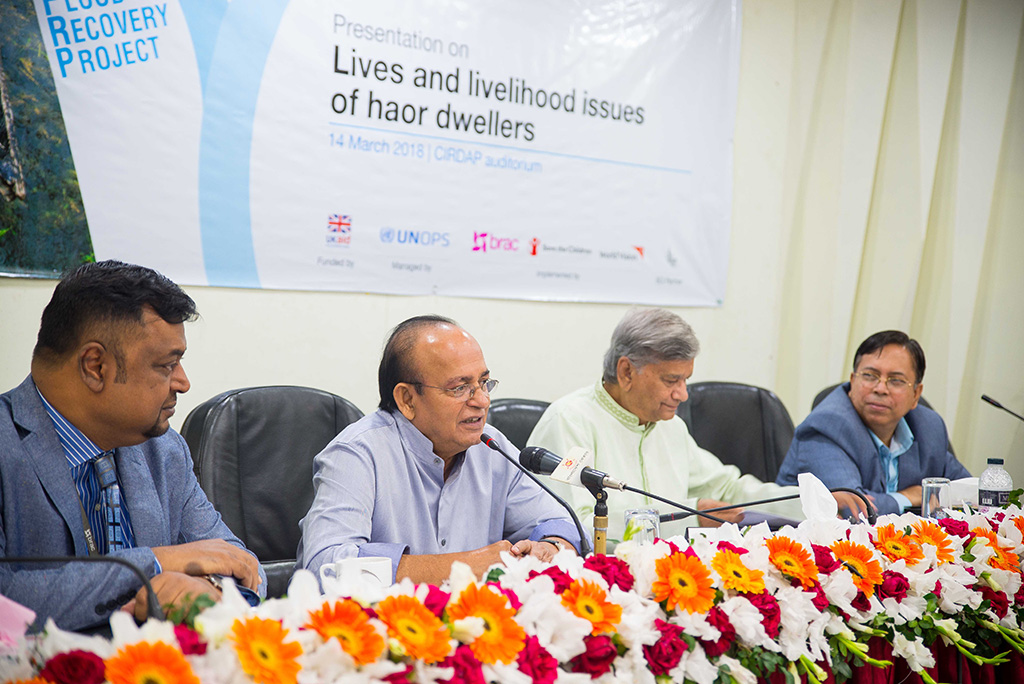
Improved early warning system, long-term farming plan, embankment construction and repair and alternative employment stressed
Establishment of manufacture plants to create alternative employment opportunity, assistance for women entrepreneurs and effective measures to prevent and control river erosion include the essential measures for the development of the people haor areas in the north and northeast of Bangladesh.
The speakers stressed these points at a presentation event on a research titled 'Lives and livelihood issues of haor dwellers' organised at the CIRDAP auditorium in the capital today on Wednesday (14 March 2018). Probal Saha, water resource management specialist of the Centre for Climate Change and Environmental Research (C3ER), delivered the keynote presentation at the programme. The C3ER, a research body under BRAC University, carried out the research.
Water resources minister and lawmaker Anwar Hossain Manju attended the event as the chief guest, while state minister for finance and planning and lawmaker Muhammad Abdul Mannan was present as special guest. Moderated by BRAC Advocacy for Social Change programme's director KAM Morshed, the event was addressed by among others, senior secretary of water resources ministry Dr Zafar Ahmed Khan, Save the Children deputy country director Dr Ishtiaq Mannan, Integrated Development Programme's head Shyam Sundar and World Vision's humanitarian and emergency affairs director Dolon Josef Gomes.
C3ER conducted the study between 7 February and 15 March this year under the 'Flash flood recovery project'. BRAC, Save the Children and World Vision International are implementing the project with funding from the UKAID and managed by the UN office for the project services (UNOPS). The project was undertaken last year (2017) in the context of flash flood in the vast haor areas, severely affecting the life and livelihood of the local community.
The study was conducted among nine communities in three upazlias of two districts which are: four communities of Tahirpur upazila and three communities of Dirai upazila, both under Sunamganj and two communities of Itna upazila of Kishoreganj district. The study followed mainly a qualitative methodology in which 126 community members and 9 (nine) representatives of the local government bodies took part.
The participants mostly emphasised creation of alternative employment opportunities as an urgent measure to tackle the crisis of lack of employment in the vast haor area. Their suggestions in this regard include establishment of manufacturing units and support to promote entrepreneurship among women through training and materials such as sewing machines. They also identified a faulty market management system as a major impediment for the farmers not being able to sell their farm produces.
The study recommendations include among others, low-interest bank loans for the haor dwellers, construction and repair of embankments, long-term planning to boost agricultural production, opening 'jolmohal' (water-bodies under government jurisdiction that are leased out for fish culture) for affected people during emergencies of flash floods and other natural disasters allowing them to catch fish, and technological improvement of early warning system in weather forecast.
The water resources minister, Anwar Hossain Manju, said at the programme, 'The haor areas are affected by a complicated set of problems that cannot be solved all in one go. To effectively address the problems they need to be prioritised. Since we have resource constraints, we cannot prevent erosion in all rivers, nor can we dredge all the rivers. However, under the guidance by the honourable prime minister we are giving special priority to river dredging.'
He further stressed collaborative effort, saying, 'We would have achieved GDP growth 10 times more if we could work in coordination at all levels, including districts and unions. And, if we could prevent "wastage", which however is termed "corruption" by many, there was GDP growth 2 times more.'
State minister for finance and planning Muhammad Abdul Mannan said, 'I have much doubt about the sustainability of the crop insurance in the haor area. It is because, an insurance means that the clients will have to pay the premiums. So we have to think more how realistic option the crop insurance would be for the poor farmers of the haor.'
Dr Ishtiaq Mannan said, 'Time is extremely valuable in haor livelihood management. Resource damage cannot be prevented unless we are able to take timely action. For this involving the local community is essential for effective infrastructure management in haor.'
94% women victims of sexual harassment in public transport
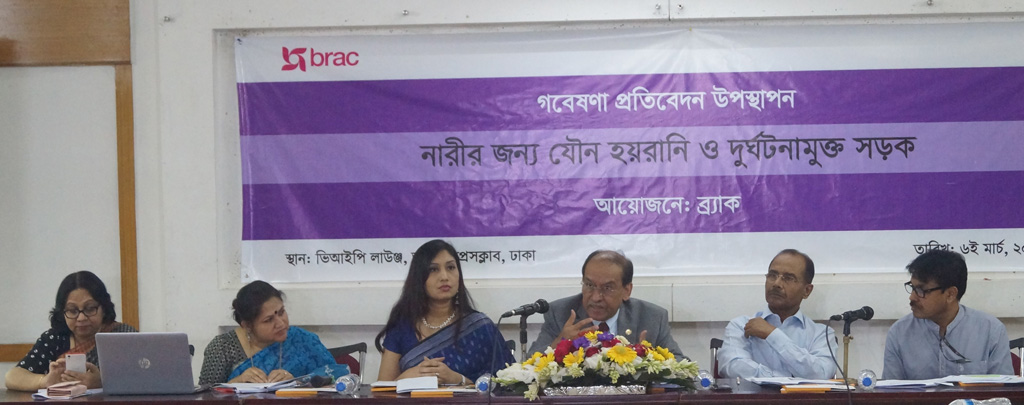
Ninety-four per cent (94%) women commuting in public transport in Bangladesh have experienced sexual harassment in verbal, physical and other forms, a study by development organisation BRAC has revealed. A somewhat surprising revelation of the study is that males belonging to relatively older age group of 41-60 years have been identified as the major perpetrators. This group has been identified as perpetrators for 66 per cent of such incidents. The study also mentions factors including lax implementation of laws, excessive crowds in the buses and weak or no monitoring (such as absence of close circuit cameras) as the major causes behind sexual harassment in roads and public transport especially in the buses.
The findings of the study titled 'Rods free from sexual harassment and crash for women' was presented at a press event today on Tuesday (6 March 2018) at the National Press Club in the capital. BRAC with assistance from BRAC University carried out the research.
Professor Syed Saad Andaleeb, Professor Simeen Mahmud, Fahmida Saadia Rahman and Kabita Chowdhury conducted the research.
Hasne Ara Begum, programme coordinator of GJ&D programme and Kabita Chowdhury, research associate of the BRAC Institute of Governance and Development under BRAC University, presented the keynote on the research findings. Professor Syed Saad Andaleeb and Ahmed Najmul Hussain, director of BRAC Road Safety Programme, spoke among others at the event. GJ&D programme coordinator Nishath Sultana moderated the programme.
BRAC organised the press event on the occasion of International Women's Day to be celebrated on 8th March and in alignment with its broader objective of promoting the agenda of creating safe public space and facilitating safe mobility for women.
Ahmed Najmul Hussain in his welcome speech said, 'BRAC is working in 100 schools along the Gazipur-Tangail highway to raise awareness about sexual harassment on road and public transport. Students and teachers will be informed on the issues of road safety and sexual harassment risk on road and will be trained raise their capacity of preventing such incidents'
The research was conducted in a three-month period between April and June last year (2017). A total of 415 women participated in the research as respondents in its quantitative and qualitative stages. In terms of localities, the study covered the women from low and lower-middle income background in urban, peri-urban and rural areas, who commute by public transport and on foot to go to workplace and other destinations. The geographic areas covered in the research are Gazipur, Dhaka and Birulia of Savar upazila in Dhaka district.
According to the research, 35 per cent respondents using public transport said they faced sexual harassment from males belonging to the age group of 19-35 years. Around 59 per cent respondents faced such harassment from the males who are 26-40 years old. The forms of sexual harassment experienced by the respondents include deliberate touching of victim's body with chest and other parts of the body, pinching, standing too close to the victim and pushing, touching of hair of the victims, putting hand on their shoulder, touching private parts of the victims. In response to the question 'What do women do when they are victim of such harassments?' 81 per cent women said they have kept silent while 79 per cent said they moved away from the place of harassment.
The research also observes that the present education system in which male and female children attend institutions separately restricts the scope for learning gender equality lessons as well as building the attitude and habit of treating both the sexes equally and with respect. To help children learn such attitude adequate training and counselling of teachers and counsellors are essential, it also observes.
Professor Syed Saad Andaleeb said that the pervasive nature of sexual harassment on road and transport calls for a much larger study that will reflect the nationwide scenario in this regard.
Habibur Rahman, programme head of GJ&D said in his closing remarks that the recommendations and observations made by the journalists at the press event will be taken into consideration for conducting studies in a larger scale.
Speakers at the event also observed that although commendable progress has been made in the country in terms of women's education and professional engagement, the feeling of insecurity among women is pervasive. To address the existing issues they demanded for stricter implementation of laws besides initiatives to raise public awareness.
BRAC Uganda, Nepal, Myanmar and Pakistan support One Billion Rising
One in three women worldwide have been beaten or raped during their lifetime, according to a publication by the World Health Organisation. With a world population of 7 billion, that is more than one billion women and girls. At BRAC, our vision is a world free from all forms of exploitation and discrimination where everyone has the opportunity to realise their potential. This vision can only be achieved if men and women around the world work together to end violence, exploitation and discrimination against women.
One Billion Rising (OBR) first launched on Valentine’s Day in 2012 as a call to action to end violence against women. The theme of the 2018 campaign is “Solidarity Against the Exploitation of Women”. On the 14 February 2018, BRAC in Uganda, Nepal, Myanmar and Pakistan rose in solidarity with the one billion women and girls who suffer due to violence against women.
BRAC in Uganda pledged its support to the One Billion Rising campaign through writing short yet powerful slogans in a number of languages. The question 'What message would you depict to call for the end of violence against women?' was posed to country office staff to find out their attitudes towards violence against women. There were a number of clear favorites, such as "Pamper her, don't batter her" and "Humankind = Womankind Mankind. Women are human too".
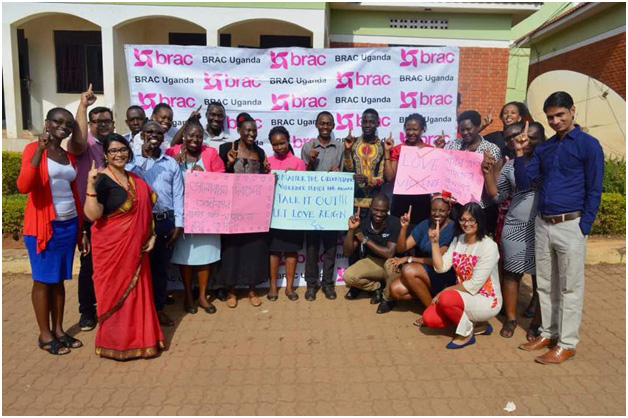 BRAC Uganda country office staff promote OBR
BRAC Uganda country office staff promote OBR
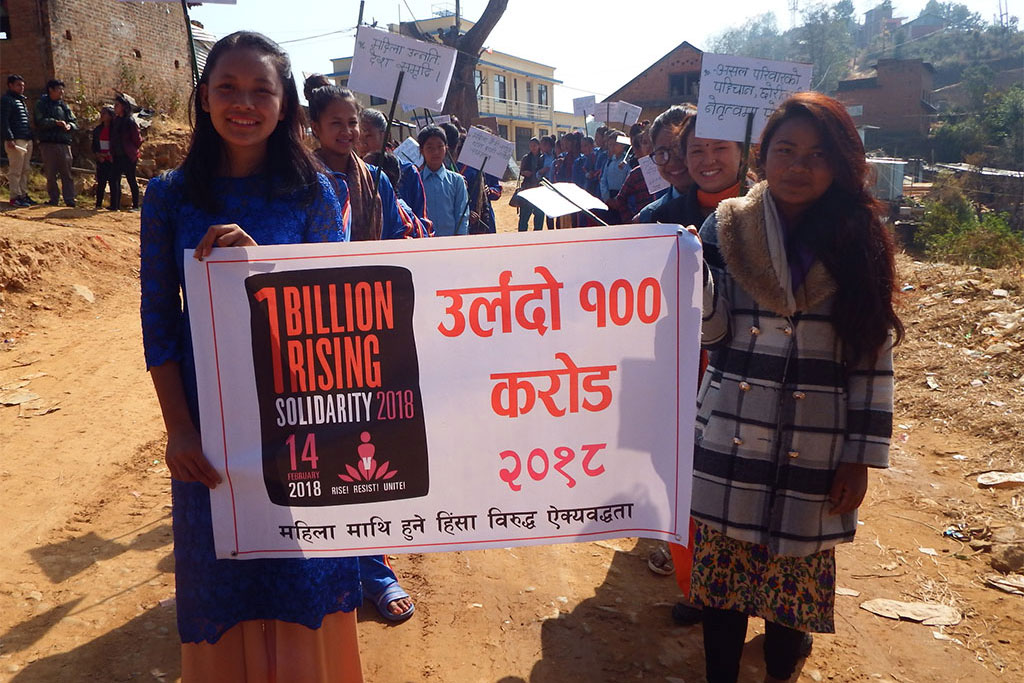 Adolescent girls’ club members and female community health volunteers rally for OBR in Nepal
Adolescent girls’ club members and female community health volunteers rally for OBR in Nepal
 BRAC Myanmar staff at their stall for OBR in People’s Park, Yangon
BRAC Myanmar staff at their stall for OBR in People’s Park, Yangon
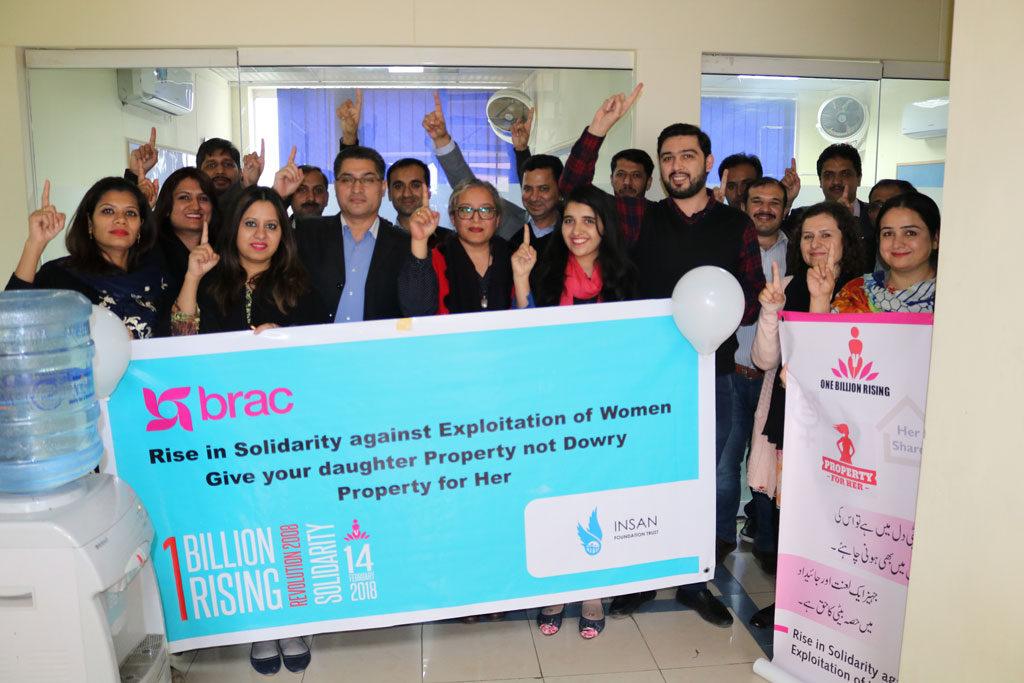 BRAC Pakistan promotes OBR through a learning and awareness session
BRAC Pakistan promotes OBR through a learning and awareness session
In Nepal, 100 adolescent girls’ club members, female community health volunteers and BRAC staff participated in rallies ending at three local government offices. Videos of ‘Break the Chain’ and past OBR events in different parts of Nepal were shown. A collective appeal letter signed by more than 200 adolescent girls and women of the community was presented to the ward chairpersons with the aim of ending child marriage in the community.
BRAC in Myanmar supported the cause at an OBR event organised by the Men Engaging Working Group Myanmar at People’s Park, Yangon. Awareness of the campaign was raised through games, music and dance. The staff of BRAC Myanmar wrote slogans and distributed pamphlets from a BRAC stall to show their support of OBR and gender equality.
BRAC in Pakistan held a learning and awareness session with OBR coordinators and special guest Kishwar Sultana, CEO of Insan Trust Foundation. Women’s right to property was the main topic of discussion to promote ‘Property For Her’, a new OBR campaign in South Asia which aims to secure land and property rights for women. In south Asian culture and Pakistani societies, women are mostly given dowries and denied their property rights. Participants shared their experiences of instances where the birth of a girl was not welcomed. Videos, speeches and poetry were presented to highlight how property rights for women can change these perceptions which discriminate against women and girls.
Dutch Postcode Lottery supports BRAC in fighting extreme poverty in Liberia
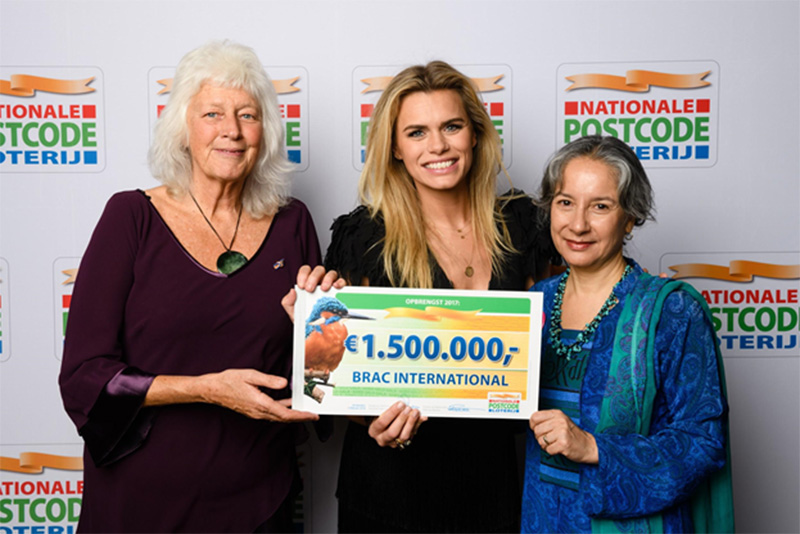 Sylvia Borren, vice-chair (left) of BRAC International, Nicolette van Dam (middle) ambassador of the Postcode Lottery and Fawzia Rasheed (right) board member of BRAC International. Credits: Roy Beusker Fotografie.
Sylvia Borren, vice-chair (left) of BRAC International, Nicolette van Dam (middle) ambassador of the Postcode Lottery and Fawzia Rasheed (right) board member of BRAC International. Credits: Roy Beusker Fotografie.
Friday, February 16 - BRAC, for the first time ever, received a contribution of 1.5 million euros from the Dutch National Postcode Lottery to combat extreme poverty in Liberia. BRAC will employ their proven approach to permanently lift women and families (those who live on less than 1.69 euros a day) out of extreme poverty.
BRAC has helped 1.7 million families in Bangladesh out of extreme poverty through its graduation approach. It provides a step-by-step guide to women, who in two years time, “graduate” permanently from extreme poverty along with their families. "With this fantastic contribution from the Postcode Lottery, we can do in Liberia what we already achieved on a large scale in Bangladesh," said Sir Fazle Hasan Abed, the founder and chairperson of BRAC.
Natural allies
According to Sir Fazle, the Postcode Lottery and BRAC are natural allies. The Postcode Lottery involves millions of people in strengthening charities, while BRAC helps millions of people to fight poverty through piloting, perfecting and scaling projects. BRAC is currently operating in 11 countries in Asia and Africa with a holistic and integrated approach to fighting poverty consisting of education, agriculture, microcredits, health and strengthening of girls' and women’s rights.
BRAC’s graduation approach is highly recognised by prominent international researchers from Yale, Massachusetts Institute of Technology and the London School of Economics, amongst others. Studies have repeatedly proven the effectiveness of the model, and the results are permanent. The graduation approach has been adopted by governments and NGOs in 37 countries. BRAC is targeting to lift a further one million people out of extreme poverty through this approach.
"BRAC realised that, despite 40 years of programmes and strategies, it still could not reach the poorest group. The people who are invisible and can not participate in their community because they are too poor. We listen, involve from day one, people from the community. We start small- test, adjust, test again- and scale to large numbers of families, in more villages and slums, and regions and eventually to a whole country.”
-Sylvia Borren, vice-chair, BRAC International.
BRAC Liberia awarded Outstanding International NGO of the Year for 2017
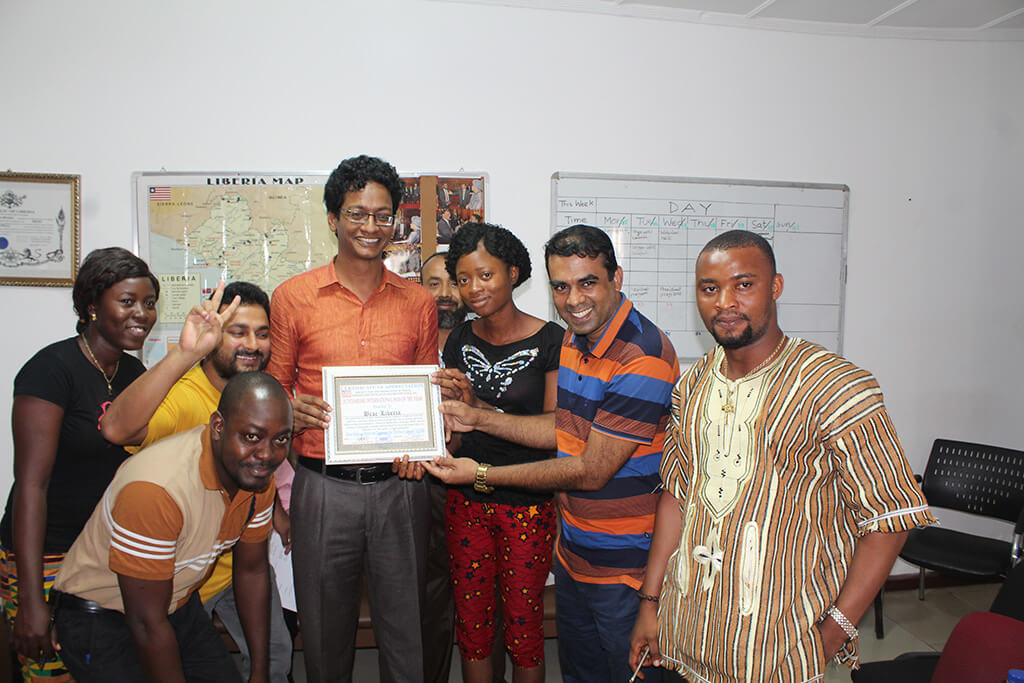
BRAC Liberia was awarded ‘Outstanding International NGO of the Year’ for 2017 by the Society for the Promotion of Peace, National Reconciliation and Reunification (SPPNRR) on Thursday, 9 February 2018.
J Mayfield Copson, national chairman and chief executive office of SPPNRR, spoke of the award, “We honour you, BRAC Liberia, as a good, reliable and productive capacity-building international NGO of the Year 2017, for your invaluable and measurable contributions towards society’s good, for which you are present across 10 of our 15 political subdivisions.”
Md Abdus Samad, BRAC Liberia’s senior programme manager for education, and the empowerment and livelihood for adolescents, thanked SPPNRR for bestowing the award, promising to work even harder to deserve such an award again. He spoke of BRAC’s pride in working towards alleviating poverty, and ending exploitation and discrimination of all forms in Liberia. He added that BRAC’s promotion of diversification and capacity development has resulted in the placement of more Liberians in senior management positions within the organisation.
According to World Bank, 54% of Liberia’s population lives below the poverty line. Since 2008, BRAC Liberia has taken holistic, integrated approaches to combating poverty, including programmes in microfinance, health, empowerment and livelihood for adolescents, education, and food security and livelihoods.
Promoting nutrition awareness to fight malnutrition
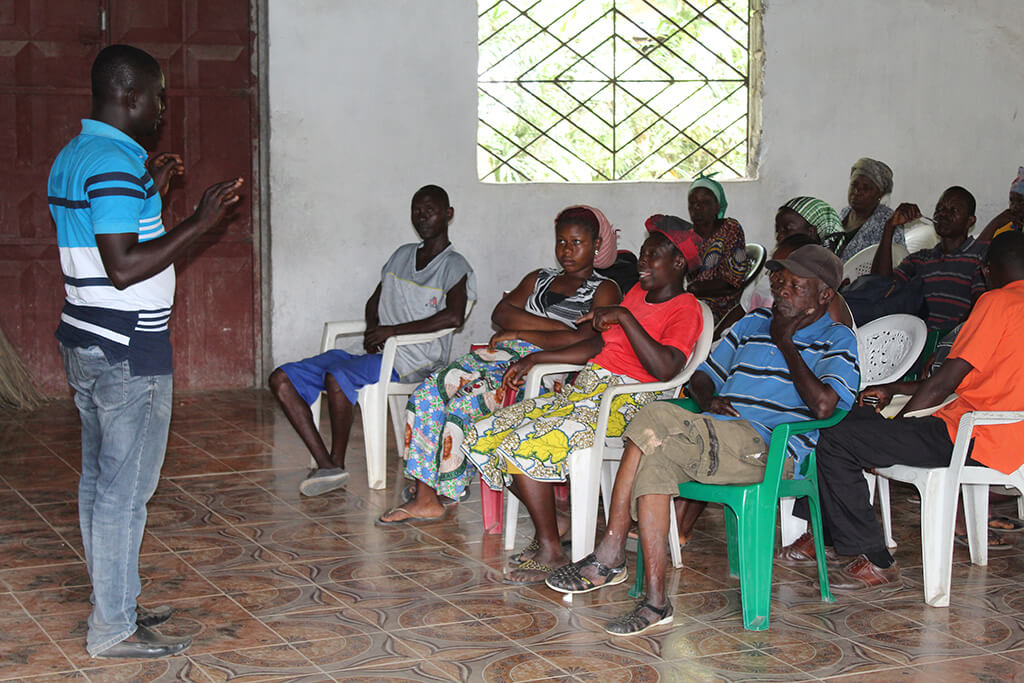
BRAC, in collaboration with the Government of Liberia and the European Union under its Pro ACT 2015 food security project are implementing a series of nutrition awareness activities to reduce the prevalence of malnutrition in the country.
Liberia stands at 177 out of 188 countries in the UNDP Human Development Index (2016). 32% of children under five years are stunted and 15% are underweight (USAID).
BRAC is conducting nutrition awareness campaigns (NAC) and mother forum sessions as a way of reducing the prevalence of malnutrition in all its forms, including micronutrient deficiencies. In 2017, 910 mothers, pregnant women, and other women of child-bearing ages were enrolled into mothers forums totalling 91 NAC groups comprising 10 members each, and seven per branch. Members are taught the importance of food diversification (eating from the five food groups), feeding practices of pregnant women and children, women nutrition, care of sick and malnourished children, prevention of vitamin A deficiency, as well as consumption of iodine salt and comprehensive homestead development.
Ms Thon Okanlawon, a nutrition officer, has noticed that food diversification and exclusive breastfeeding are already being practiced by project participants. “The participants take into their localities knowledge gained under the programme as a way of promoting active lifestyle changes,” she remarks. “Some of what they are being taught was not practised in the past, but they are now well prepared to change eating habits and breastfeeding practices which reduces malnutrition and micronutrients deficiencies, as well as stunting.”
The project currently operates in 13 branches in six of the 15 counties of Liberia, (Montserrado, Margibi, Bong, Grand Bassa, Bomi and Grand Cape Mount) with similar expansion planned for the next phase running from September 2017 to September 2018.
Burning issue: Dhaka slums fight fires but land problems loom
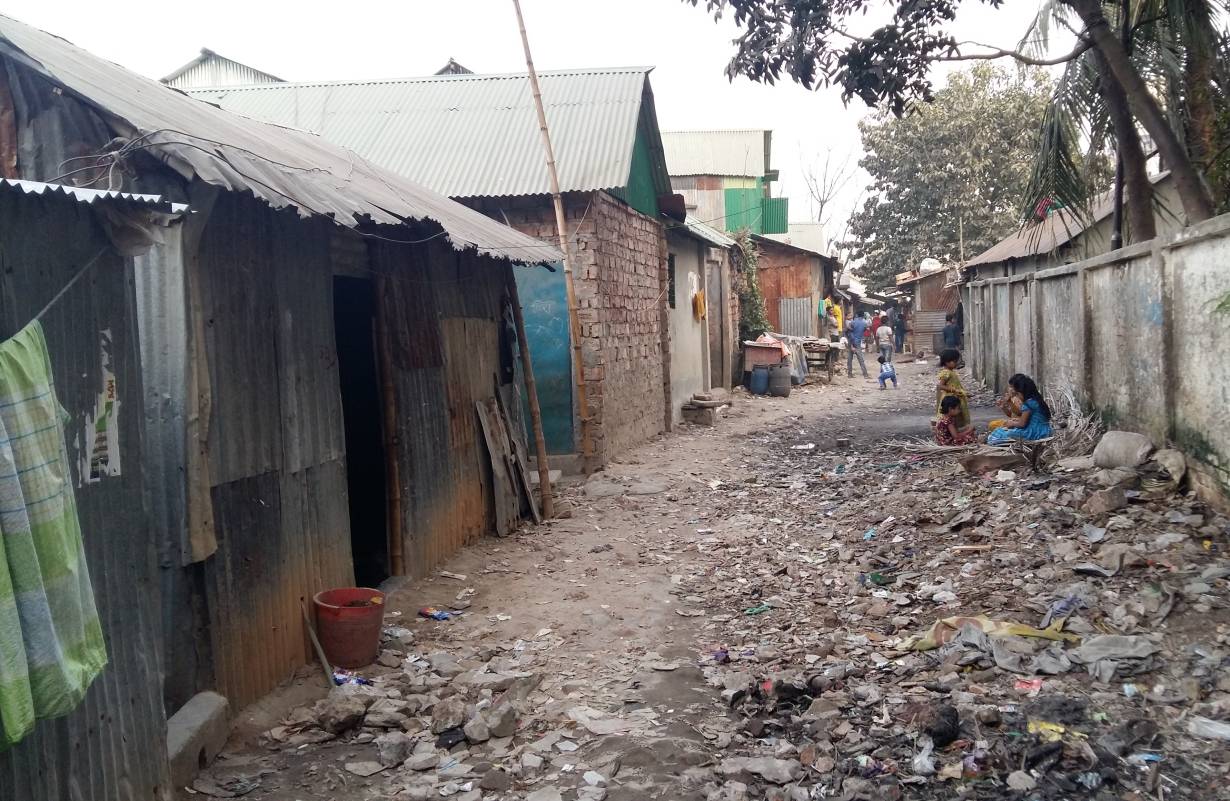
DHAKA, Feb 1 (Thomson Reuters Foundation) - Bilkis Begum has lived on the lakeside in Dhaka's Korail slum for 16 years, but in December 2016, her extended family's 12 houses were razed to the ground by a fire.
The inferno destroyed the oven her husband, Shahid Gazi, used for his bakery and the fridges he relied on for his business selling leftover chicken meat from Chinese restaurants.
For the Gazis, it was a struggle to cobble together the $3,000 they needed to rebuild their homes and business.
They borrowed $900 from moneylenders, and found the rest from relatives and friends. They also got tin, pillars and a little cash aid from Bangladesh-based development agency BRAC.
In addition, they received pro-bono help from architects like Sheikh Rubaiya Sultana, who helped redesign the neighbourhood to protect it better against future fires.
"Architects have social responsibility," said Sultana, an assistant professor at BRAC University in Dhaka. "I watched the fire before my very eyes, but couldn't do anything then."
The Gazi family now has eight new units and the couple are back in business, running a small restaurant on the old site.
"We couldn't have stood back on our own feet unless we got (this) support," said Begum, 32, a mother of three.
A team of 16 architects, planners, engineers and students, brought together by BRAC, has tested out simple, cheap design solutions to rebuild Dhaka's two biggest slums after fires destroyed some 650 homes in late 2016, affecting 2,500 people.
The new approach aims to tackle the ever-present threat of fires in Dhaka's crowded slums, while improving living conditions for residents.
But in a city where less than 10 percent of areas are planned, altering the slumscape is a tall order.
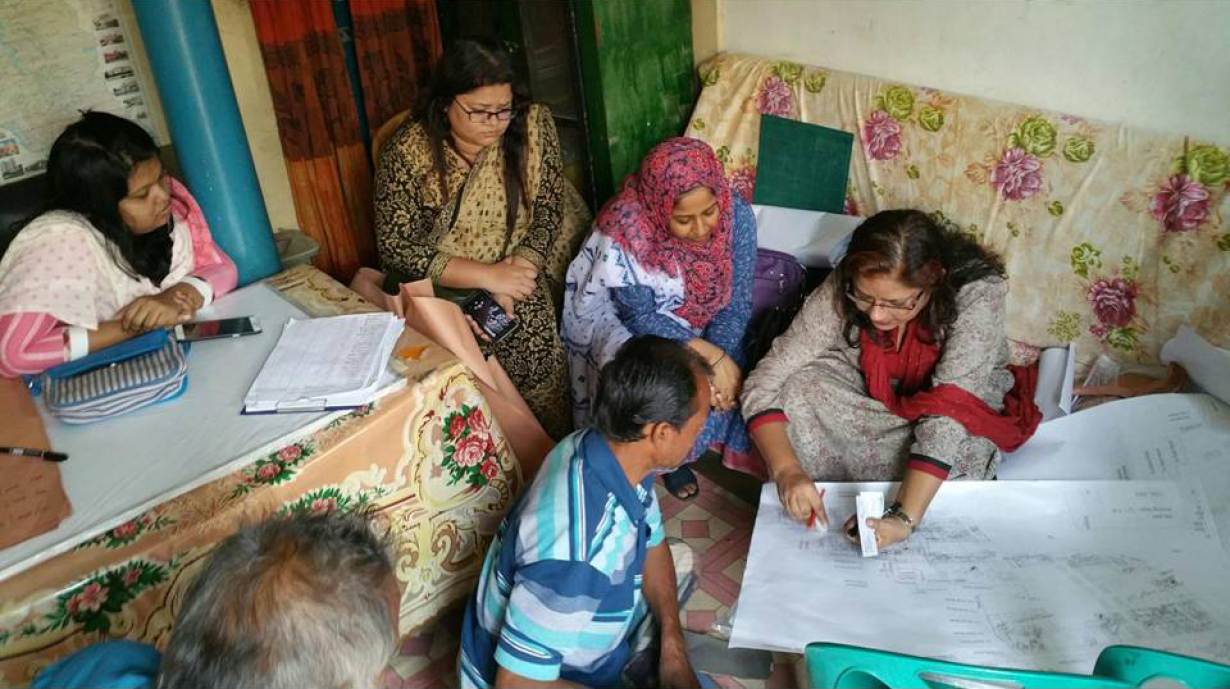 A team of volunteer architects led by Aforza Ahmed of J.A. Architects works with a home owner in Korail slum, locating his home on a map drawn up by them in Dhaka, Bangladesh. HANDOUT/J.A. Architects Ltd
A team of volunteer architects led by Aforza Ahmed of J.A. Architects works with a home owner in Korail slum, locating his home on a map drawn up by them in Dhaka, Bangladesh. HANDOUT/J.A. Architects Ltd
LACK OF LAND RIGHTS
One major challenge is working out what is feasible for slum residents who have no legal rights to the land they live on.
Ashekur Rahman, an urban programme specialist with the United Nations Development Programme (UNDP) in Bangladesh, said the transitory existence of many slum dwellers is a major impediment to keeping them safe from threats like fires in the longer term.
Many are seasonal migrants who split their time between villages and cities, limiting their access to services and permanent accommodation.
Government providers worry that improving services in informal settlements could attract more migrants from rural areas, Rahman said.
"Weak and ill-defined land tenure and property rights pose big threats to resilience-building and are considered the underlying causes of the poverty and vulnerability of the urban poor in Bangladesh," he added.
WIDER ROADS
Sandwiched between Dhaka's upscale Gulshan and Banani neighbourhoods, Korail - which sprang up in the 1980s - sprawls over some 170 acres of land owned by three government ministries.
It is home to as many as 100,000 residents, including rickshaw drivers, domestic helpers, garment workers and small traders.
Fire is just one of the threats inhabitants face on a daily basis, which include eviction, drugs, crime, police harassment and extortion.
After digitally mapping the fire-hit areas, the design team led by Dhaka-based J.A. Architects Ltd consulted with residents who each agreed to give up a tiny amount of space to widen access roads and narrow lanes so that fire trucks and ambulances could enter if another blaze breaks out.
The group of experts was appalled by the unhygienic conditions in the slums. In summer, the tin shacks are "like ovens", said Shamim Hossain, a manager with BRAC's urban development programme.
To improve living conditions, the team made modifications to dwellings, such as adding windows, wire netting and transparent plastic to let in air and light.
They also helped rebuild homes in Sattola slum, which suffered a major fire in December 2016 too, destroying 115 homes in just 10 minutes.
Made homeless overnight, residents had to pass more than three cold winter months under the open sky.
MORE AIR, LIGHT
In the slum, which is home to 50,000 people and located on land belonging to the health ministry, residents have since built concrete houses with green tin roofs to reduce losses in the event of a fire - despite the risk of eviction as the government plans to build a physiotherapy college there.
The new design has allowed some homeowners to afford a luxury - a communal area – as well as an upstairs.
In the family space, where children play and adults gossip while sipping tea, Rabeya Akhter recalls how she clambered out of the house when her brother-in-law shouted "Fire! Fire!" just after midnight on December 12, 2016.
Her family lost valuables worth about $600 when their TV, PC monitor, wardrobe and other furniture burned to ashes.
They managed to get credit of more than $3,600 to rebuild their home, mostly from Dhaka-based micro-finance institution DSK.
Shah Alam, who co-owns a two-storey home, has used metal netting for corridor walls and plastic roofing in parts to ensure it is ventilated and well-lit – an idea partly his own and partly from the volunteer architects.
RURAL MIGRANTS
Like Akhter's father-in-law Siddiq Howladar, 70, who moved to Dhaka from the southern island-district of Bhola, many of Sattola's residents migrated from coastal Bangladesh, where land erosion and floods are common, poverty is pervasive and jobs are rare.
Dhaka alone attracts an estimated half a million rural migrants seeking employment each year, according to the World Bank. Almost one-third of its population of 18 million lives in slums.
Government figures show some 20,000 fires occur annually in Dhaka. But the cause often remains unknown, and the blazes get little international attention.
Residents of the capital's Kalyanpur slum suspected a fire that gutted dozens of homes in early 2016 was started deliberately to remove them from land owned by the ministry of housing and public works, local media reported.
It happened a day after a court order to halt an eviction that had sparked violence between inhabitants and police.
Abu Obaidur Rahman, a lawyer with the Bangladesh Legal Aid and Services Trust, told the Thomson Reuters Foundation the fire had "accelerated the eviction process", although the Dhaka-based charity had no evidence of who started it.
"Slum dwellers are citizens of this country and they make a contribution to the city," he said. "The government has the responsibility to rehabilitate them."
"TEMPORARY" RESIDENTS?
While the transformation of parts of Korail and Sattola has made residents less vulnerable to fires, the thorny question of land tenure persists.
City councillor Mofizur Rahman described Korail's residents as "temporary" and said they would have to vacate the land when the government starts to build an IT park there.
Under a new programme to reduce urban poverty, the UNDP aims to resettle people on unused or under-used government land, and broker medium-term tenure deals between private land owners and tenants, said the agency's Rahman.
Hossain Zillur Rahman, executive chairman of the Power and Participation Research Centre, a Dhaka-based think-tank, believes urban policy must become "humane" so that slum dwellers can get more secure land tenure.
Supporting reconstruction in the fire-hit slums was the "right decision" but it did not advance residents' legal rights, he noted.
For now, Korail and Sattola are "more liveable than before", said BRAC's Hossain.
"It's a start," said architect Sultana. "Others can follow it."
More...
Join the world’s biggest family

